高中英语状语从句详解表格例句
- 格式:doc
- 大小:99.50 KB
- 文档页数:6
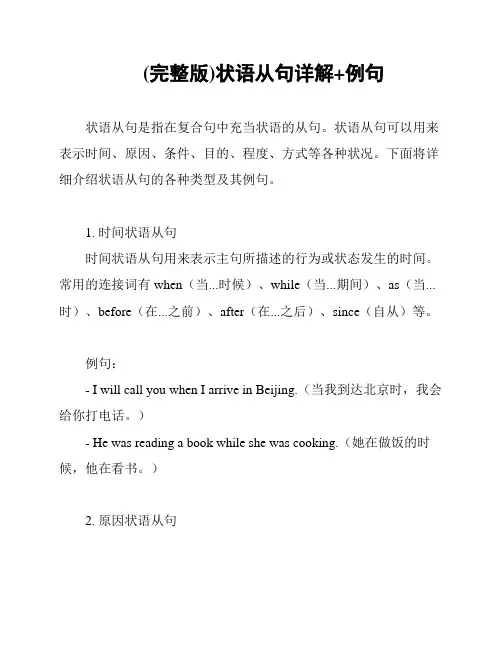
(完整版)状语从句详解+例句状语从句是指在复合句中充当状语的从句。
状语从句可以用来表示时间、原因、条件、目的、程度、方式等各种状况。
下面将详细介绍状语从句的各种类型及其例句。
1. 时间状语从句时间状语从句用来表示主句所描述的行为或状态发生的时间。
常用的连接词有when(当...时候)、while(当...期间)、as(当...时)、before(在...之前)、after(在...之后)、since(自从)等。
例句:- I will call you when I arrive in Beijing.(当我到达北京时,我会给你打电话。
)- He was reading a book while she was cooking.(她在做饭的时候,他在看书。
)2. 原因状语从句原因状语从句用来表示主句所描述的行为或状态的原因。
常用的连接词有because(因为)、since(因为)、as(由于)、for (因为)等。
例句:- I can't go to the party because I have to work.(我不能去参加派对,因为我得工作。
)- Since it is raining, we should stay at home.(由于下雨了,我们应该待在家里。
)3. 条件状语从句条件状语从句用来表示主句所描述的行为或状态的前提条件。
常用的连接词有if(如果)、unless(除非)、whether(无论)、provided(倘若)等。
例句:- If it rains tomorrow, we will stay indoors.(如果明天下雨,我们会呆在室内。
)- We can go shopping unless it is too late.(除非太晚,否则我们可以去购物。
)4. 目的状语从句目的状语从句用来表示主句所描述的行为或状态的目的。
常用的连接词有so that(以便)、in order that(为了)、lest(免得)等。
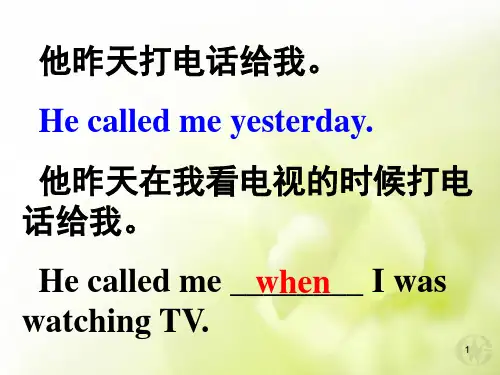
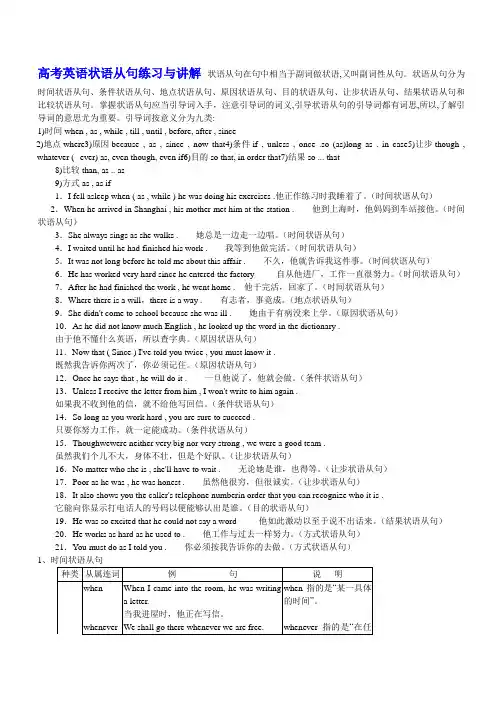
高考英语状语从句练习与讲解状语从句在句中相当于副词做状语,又叫副词性从句。
状语从句分为时间状语从句、条件状语从句、地点状语从句、原因状语从句、目的状语从句、让步状语从句、结果状语从句和比较状语从句。
掌握状语从句应当引导词入手,注意引导词的词义,引导状语从句的引导词都有词思,所以,了解引导词的意思尤为重要。
引导词按意义分为九类:1)时间when , as , while , till , until , before, after , since2)地点where3)原因because , as , since , now that4)条件if , unless , once .so (as)long as . in case5)让步though , whatever (--ever) as, even though, even if6)目的so that, in order that7)结果so ... that8)比较than, as .. as9)方式as , as if1.I fell asleep when ( as , while ) he was doing his exercises .他正作练习时我睡着了。
(时间状语从句)2.When he arrived in Shanghai , his mother met him at the station .他到上海时,他妈妈到车站接他。
(时间状语从句)3.She always sings as she walks .她总是一边走一边唱。
(时间状语从句)4.I waited until he had finished his work .我等到他做完活。
(时间状语从句)5.It was not long before he told me about this affair .不久,他就告诉我这件事。
(时间状语从句)6.He has worked very hard since he entered the factory 自从他进厂,工作一直很努力。
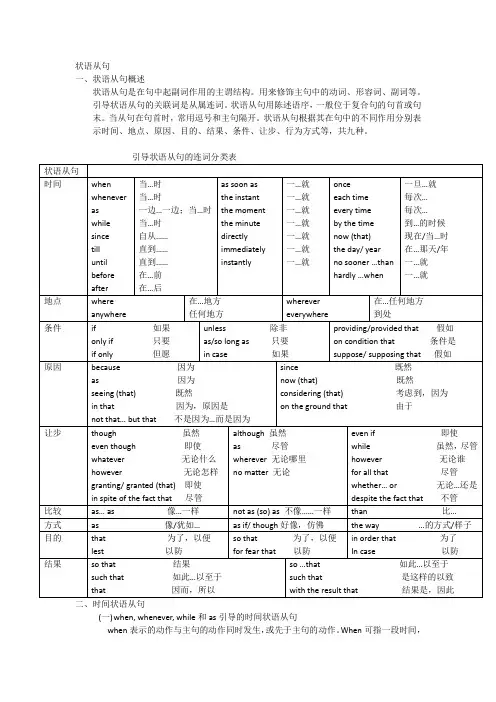
状语从句一、状语从句概述状语从句是在句中起副词作用的主谓结构。
用来修饰主句中的动词、形容词、副词等。
引导状语从句的关联词是从属连词。
状语从句用陈述语序,一般位于复合句的句首或句末。
当从句在句首时,常用逗号和主句隔开。
状语从句根据其在句中的不同作用分别表示时间、地点、原因、目的、结果、条件、让步、行为方式等,共九种。
(一)when, whenever, while和as引导的时间状语从句when表示的动作与主句的动作同时发生,或先于主句的动作。
When可指一段时间,也可指一点时间,既可以表示一时性的动作,又可表示持续的动作。
Whenever指的是任何一个不具体的时间。
while常用来引导两个同时进行的持续时间较长的动作或状态,不能表示一时性或短暂的动作。
as表示的动作与主句同时发生,具有延续的含义,一般同延续性动词连用。
while和as可译为“一边……一边”。
Whenever my mother or I need a permanent or trim we visited her dear Amalia Toland.As the day progressed, I considered ways to get out of whatever was going down at the Cullen House tonight.Whenever we met with difficulties, they came to help us.When I meet the right man, I will get married.As spring warms the good earth, all flowers begin to bloom.He entered the room when/ while/ as the meeting was going on.When/As he finished the speech, the audience burst into applause.Tom watched TV as he had supper.注意:When和while可用作并列连词,when含义为“突然、这时”;while含义为“而,但是”。
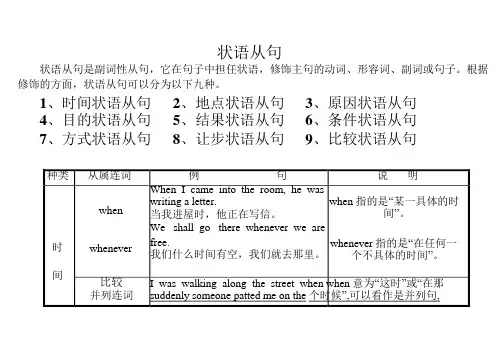
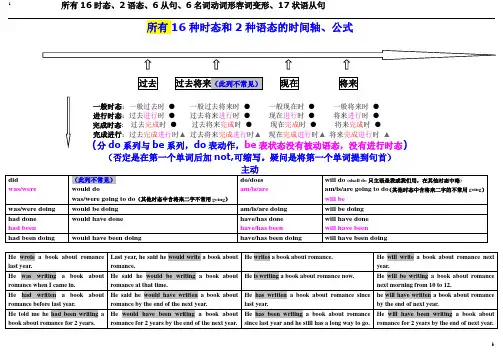
一般时态:一般过去时●一般过去将来时●一般现在时●一般将来时●
进行时态:过去进行时●过去将来进行时●现在进行时●将来进行时●
完成时态: 过去完成时●过去将来完成时●现在完成时●将来完成时●
完成进行:过去完成进行时▲过去将来完成进行时▲现在完成进行时▲将来完成进行时▲(分do系列与be系列,do表动作,be表状态没有被动语态,没有进行时态) (否定是在第一个单词后加not,可缩写。
疑问是将第一个单词提到句首)
被动
(只在不必或不愿说出动作发出者时用)
(把主动的do, doing, done分别换成done, being done, been done)
口诀:三单3变,形动过分4变,名较高5变。
现分y不变,过分较高有重闭。
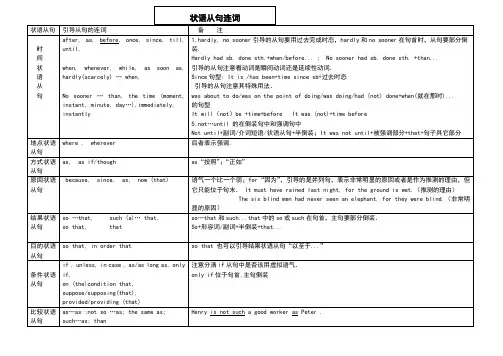
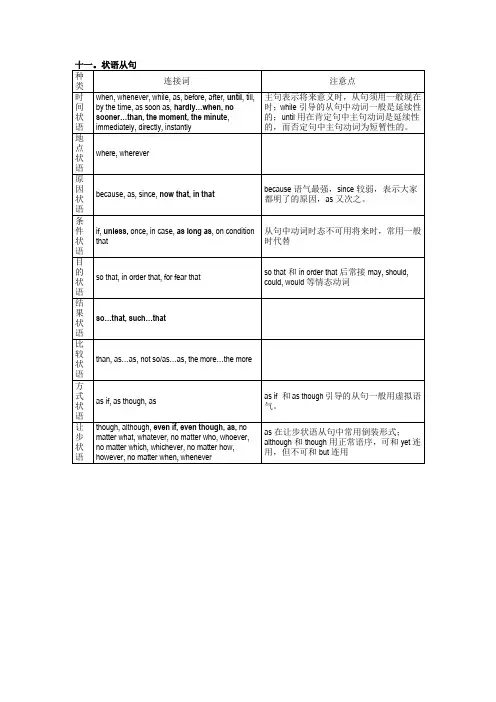
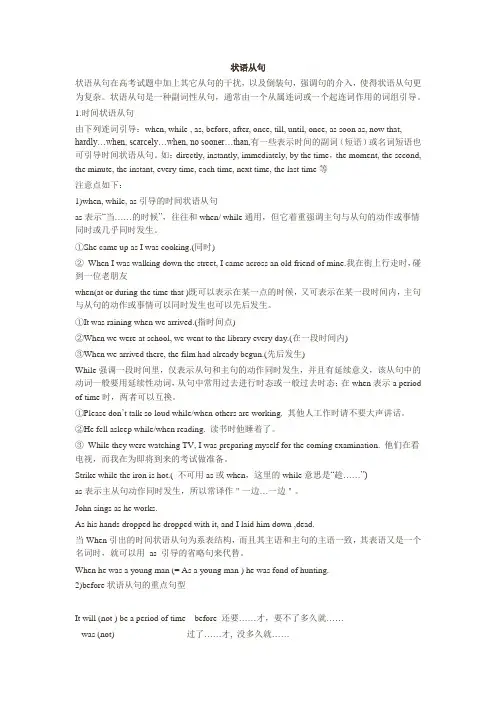
状语从句状语从句在高考试题中加上其它从句的干扰,以及倒装句,强调句的介入,使得状语从句更为复杂。
状语从句是一种副词性从句,通常由一个从属连词或一个起连词作用的词组引导。
1.时间状语从句由下列连词引导:when, while , as, before, after, once, till, until, once, as soon as, now that, hardly…when, scarcely…when, no sooner…than,有一些表示时间的副词(短语)或名词短语也可引导时间状语从句。
如:directly, instantly, immediately, by the time,the moment, the second, the minute, the instant, every time, each time, next time, the last time等注意点如下:1)when, while, as引导的时间状语从句as表示“当……的时候”,往往和when/ while通用,但它着重强调主句与从句的动作或事情同时或几乎同时发生。
①She came up as I was cooking.(同时)②When I was walking down the street, I came across an old friend of mine.我在街上行走时,碰到一位老朋友when(at or during the time that )既可以表示在某一点的时候,又可表示在某一段时间内,主句与从句的动作或事情可以同时发生也可以先后发生。
①It was raining when we arrived.(指时间点)②When we were at school, we went to the library every day.(在一段时间内)③When we arrived there, the film had already begun.(先后发生)While强调一段时间里,仅表示从句和主句的动作同时发生,并且有延续意义,该从句中的动词一般要用延续性动词,从句中常用过去进行时态或一般过去时态;在when表示a period of time时,两者可以互换。

英语状语从句的讲解和例子英语状语从句的讲解和例子状语从句是一种从句,它位于句子的其他成分之前,作状语,表示时间、原因、条件、让步、结果、目的、方式、比较等意义。
状语从句中的动词要用陈述句语序,即谓语动词用一般现在时,谓语动词变成主语前有任何插入语时,谓语动词用一般过去时。
1、时间状语从句时间状语从句的关联词有:when,while,as,before,after,since,until,as soon as,hardly…when,no sooner…than,the moment,as long as,whenever等。
例句:1) I will go there when I finish my work.2) We had scarcely arrived when it started to rain.2、原因状语从句原因状语从句的关联词有:as,because,since,now that,for,in that,inasmuch as,as if,as long as,where(as)等。
例句:1) I can't go out because I have to finish my homework.2) As he was ill, he couldn't go to school.3、条件状语从句条件状语从句的关联词有:if,unless,only if,provided(that),supposing(that),in case,on condition(that),even if,so longas等。
例句:1) If it rains tomorrow, we won't go out.2) I will finish the work even if it takes me all night.4、让步状语从句让步状语从句的关联词有:though,although,while,whereas,no matter(how),whatever,regardless(of)等。
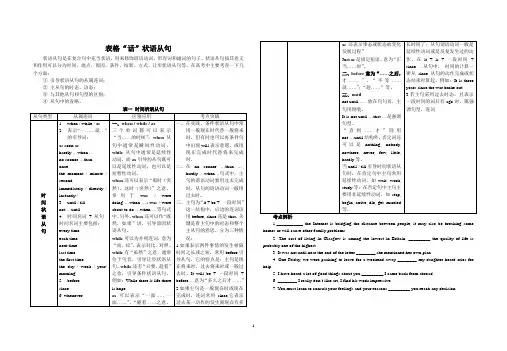
表格“话”状语从句状语从句是在复合句中充当状语,用来修饰谓语动词、形容词和副词的句子。
状语从句按其意义和作用可以分为时间、地点、原因、条件、结果、方式、让步状语从句等。
在高考中主要考查一下几个方面:①引导状语从句的从属连词;②主从句的时态、语态;③与其他从句和句型的区别;④从句中的省略。
考点例析1.___________ the Internet is bridging the distance between people, it may also be breaking some homes or will cause other family problems.2. The cost of living in Glasgow is among the lowest in Britain, _________ the quality of life is probably one of the highest.3. It was not until near the end of the letter ________ she mentioned her own plan.4. One Friday, we were packing to leave for a weekend away ________ my daughter heard cries for help.5. I have heard a lot of good things about you _________ I came back from abroad.6. ________ I really don‟t like art, I find his work impressive.7. You must learn to consult your feelings and your reasons _________ you reach any decision.表二地点状语从句考点例析1. A number of high buildings have arisen ________ there was nothing a year ago but ruins.2.In peace too, the Red Cross is expected to send help ___________ there is human suffering.3.Everything was placed exactly___________ he wanted it for the graduation ceremony.1.Mark needs to learn Chinese ____________ his company is opening a branch in Beijing.2.He found it increasingly difficult to read, _________ his eyesight was beginning to fail.句型转换He is so young that he can‟t join the army.= He is ________ ___________ __________ join the army.= He is ________ ___________ __________ to join the army.= He is so young __________ ___________ ___________ join the army.表五方式状语从句考点例析考点例析1.I don ‟t believe we ‟ve met before, __________ I must say you do look familiar.2. _____________ I have to give a speech, I get extremely nervous before I start.3. One can always manage to do more things, no matter _____________ full one ‟s schedule is in life.4. —— Look at those clouds!—— Don ‟t worry. __________ it rains, we …ll still have a great time.表八 比较状语从句动词。
状语从句The Examples of Adverbial Clauses状语从句一、时间状语从句when, while, as, whenever, till, until, after, before, since, once, every/each time, the day一...就...1.As soon as2.The moment/minute/second/instant3.Immediately/instantly/directly4.No sooner...than... hardly/scarcely...when...Than/when 后采用一般过去时,主句采用过去完成时,主倒从不倒。
(adv./prep.位于句首,部分倒装)1.when, while, aswhen用法最广,常可代替while和as, as引导的时间状语从句既可以是延续性动词,又可以是非延续性动词;而while所引导的时间状语从句谓语动词只能是延续性动词,并常与进行时态连用。
1). When I lived in the countryside, I used to carry some water for him.2). While my wife was reading the newspaper, I was watching TV.3). As we were going out, it began to snow.when一般强调特定时间,还可表示:1.就在这时/就在那时突然...2.还没...就...3.一...就...4). When spring came, he felt like a trip.5). We were about to to leave when he came in.6). I had hardly sat down when he stepped in.=Hardly had I sat down when he stepped in.While所引导的时间状语从句强调主句和从句的动作同时发生或相对应,也表示对比。
状语从句例句英语1. 时间状语从句(Adverbial Clause of Time)- When she arrived, the party had already started.- Before you go to bed, make sure all the lights are turned off.2. 原因状语从句(Adverbial Clause of Cause)- Because it was raining, we decided to stay at home.- Since you are already late, you might as well take your time.3. 条件状语从句(Adverbial Clause of Condition)- If it rains tomorrow, we will cancel the trip.- Unless you study harder, you won't pass the exam.4. 结果状语从句(Adverbial Clause of Result)- So loudly did he shout that everyone heard him.- She was so tired that she fell asleep immediately.5. 目的状语从句(Adverbial Clause of Purpose)- In order to improve his skills, he practiced every day.- He saved money so that he could buy a new car.6. 让步状语从句(Adverbial Clause of Concession)- Although it was cold, he went swimming.- While I understand your point, I don't agree with you.7. 方式状语从句(Adverbial Clause of Manner)- As if nothing had happened, she continued her work. - He sings as if he were a professional singer.8. 地点状语从句(Adverbial Clause of Place)- Wherever you go, I will follow you.- Everywhere they looked, there were signs of destruction.。
(完整版)高中英语状语从句讲解及练习状语从句状语从句在句中作状语,可分为:时间、条件、让步、原因、目的、结果、比较、地点、方式状语从句。
一、时间状语从句引导时间状语从句的连词有:when, as, while, until, not?until, before, after, since,the minute, the moment, each( every, next, the first) time 等。
时间状语从句中一般用一般现在时或一般过去时。
1.When , while, as 都可解释为“当``` 的时候”但侧重点有所不同。
1)W henEg: When I arrived home , I had a little rest.注意点:when 从句的主语与主句主语相同,谓语动词是be 动词时,从句主语和be 可以省略。
Eg: When (she was) walking along the street, she met her class teacher.2)A sAs 除了表示“当``` 的时候”,还可表示为“一面```一面”,“随着” Eg: He sang as he danced一.(面```一面)You will grow wiser as you grow older.(随着)3)While 表示“当```的时候” 强调主句的动作和从句的动作同时发生,从句一般用进行时,从句动词必须是延续性动词。
Eg: While we were working, they were having a rest.While (they were)having a discussion, they got very confused.注意点:while 有对比的含义,解释为“然而” 。
eg: I prefer black tee,while he likes coffee. 2.until, not ?until 表示“直到```才” , 在肯定句中主句常用延续性动词;在否定句中主句常用短暂性动词。
状语从句是副词性从句,它在句子中担任状语,修饰主句的动词、形容词、副词或句子。
根注意:时间状语从句(1)当主句是一般将来时、祈使句或主句中含有情态动词,这些词引导的从句要用一般现在时(主将从现)Don’t go to bed until you finish your homework.(2)When while as 的辨析A.相同点:都是“当。
时“不同点:when后用短暂性动词,指时间点,此时该从句的时态是一般现在时或一般过去时,后也可用延续性动词,指时间段,时态通常是进行时。
He was watching Tv when I came back.B.while引导的从句后必须是延续性动词,指时间段,常用进行时Someone knocked at the door while she was cooking.C.as着重指主从句同时发生“一边…一边“As we walked,we talked.(3)since 引导的从句一般用过去时,主句用现在完成时I have learnt English since I was 4 .目的状语和结果状语(1)目的状语从句引导词:so that. in order that从句中常用情态动词。
★so that既可引导目的状语从句,又可引导结果状语从句。
区别这两种从句的办法有两个:1)目的状语从句里往往带有情态动词can, could, may, mightwould等。
2)从意思上看,目的状语从句往往表示的目的很明确。
例如:Speak clearly so that they may understand you. (目的状语从句)Jack is badly ill so that he has to rest. (结果状语从句)(2)结果状语从句引导词:so...that,such...that.(3)so与such的区别①so+形+a/an+名单=such+a/an+形+名单②so+many/much/few/little+形+名(只能用so, 不用such)例如:Soon there were so many deer that they ate up all the wild roses.He has so little time that he can’t go to the cinema with you.③such+形+不可数名词/可数名词复数(4)so...that与too...to和...enough to间转换The apple is so dear that I can’t buy it.=The apple is too dear for me to buy.=The apple isn’t cheap enough for me to buy.。
状语从句
状语是用来修饰动、形、副词的句子成分。
由副词,介词短语,分词,分词短语,不定式,从句来充当。
可以表示地点,时间(伴随),原因,目的,结果,条件,让步,程度,方式,比较。
位置可在句首、中、末。
状语从句---------
●时间状语从句:when, while, as, before, after, since, till, until, by the time, as soon as,
once,
immediately, directly, instantly, the moment, the minute, the time, the day, each time, every time, any time, on doing sth, on one’s+ noun., no sooner…than, hardly…when, scarcely…when,
●地点状语从句:where, wherever,
●原因状语从句:because, since, as, now(that), seeing that, considering that, in that, for, ●目的状语从句:so, so that, in order that, in case, for fear that, lest
●结果状语从句:so, so…that…, such…that…
●条件状语从句:if, unless, as long as, so long as, in case, if only
●方式状语从句:as, (just) as…so, as if / as though
●让步状语从句:though, although, as, even if, even though, whether, while, whoever,
whatever, whichever, whenever, wherever, however, no matter who/ what/ which/ when/ where/ how,。